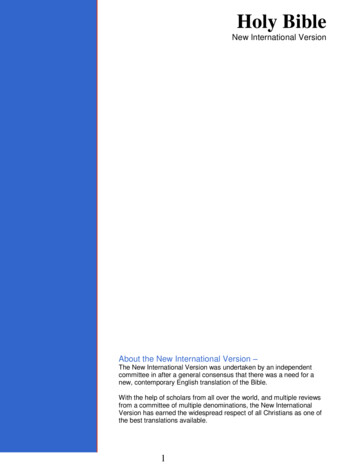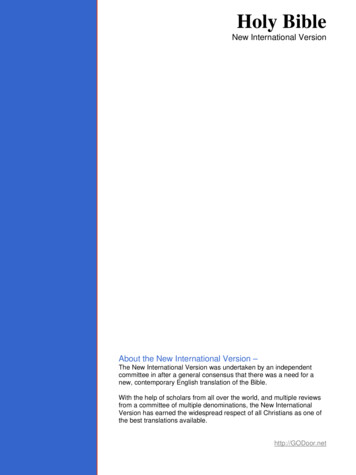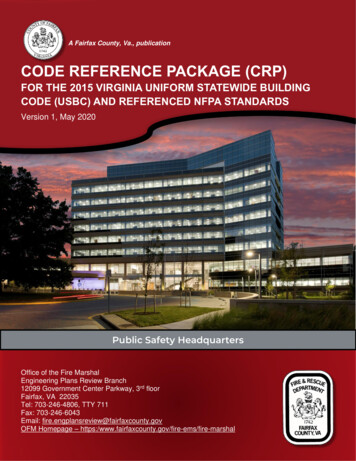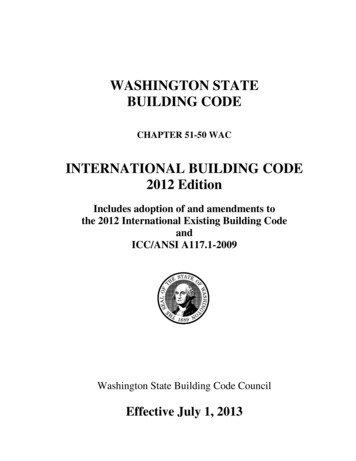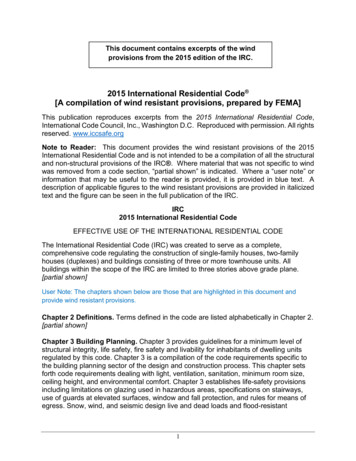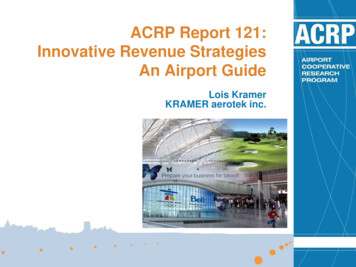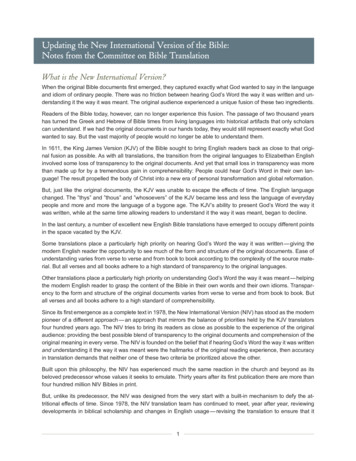
Transcription
Updating the New International Version of the Bible:Notes from the Committee on Bible TranslationWhat is the New International Version?When the original Bible documents first emerged, they captured exactly what God wanted to say in the languageand idiom of ordinary people. There was no friction between hearing God’s Word the way it was written and understanding it the way it was meant. The original audience experienced a unique fusion of these two ingredients.Readers of the Bible today, however, can no longer experience this fusion. The passage of two thousand yearshas turned the Greek and Hebrew of Bible times from living languages into historical artifacts that only scholarscan understand. If we had the original documents in our hands today, they would still represent exactly what Godwanted to say. But the vast majority of people would no longer be able to understand them.In 1611, the King James Version (KJV) of the Bible sought to bring English readers back as close to that original fusion as possible. As with all translations, the transition from the original languages to Elizabethan Englishinvolved some loss of transparency to the original documents. And yet that small loss in transparency was morethan made up for by a tremendous gain in comprehensibility: People could hear God’s Word in their own language! The result propelled the body of Christ into a new era of personal transformation and global reformation.But, just like the original documents, the KJV was unable to escape the effects of time. The English languagechanged. The ‟thys” and ‟thous” and ‟whosoevers” of the KJV became less and less the language of everydaypeople and more and more the language of a bygone age. The KJV’s ability to present God’s Word the way itwas written, while at the same time allowing readers to understand it the way it was meant, began to decline.In the last century, a number of excellent new English Bible translations have emerged to occupy different pointsin the space vacated by the KJV.Some translations place a particularly high priority on hearing God’s Word the way it was written — giving themodern English reader the opportunity to see much of the form and structure of the original documents. Ease ofunderstanding varies from verse to verse and from book to book according to the complexity of the source material. But all verses and all books adhere to a high standard of transparency to the original languages.Other translations place a particularly high priority on understanding God’s Word the way it was meant — helpingthe modern English reader to grasp the content of the Bible in their own words and their own idioms. Transparency to the form and structure of the original documents varies from verse to verse and from book to book. Butall verses and all books adhere to a high standard of comprehensibility.Since its first emergence as a complete text in 1978, the New International Version (NIV) has stood as the modernpioneer of a different approach — an approach that mirrors the balance of priorities held by the KJV translatorsfour hundred years ago. The NIV tries to bring its readers as close as possible to the experience of the originalaudience: providing the best possible blend of transparency to the original documents and comprehension of theoriginal meaning in every verse. The NIV is founded on the belief that if hearing God’s Word the way it was writtenand understanding it the way it was meant were the hallmarks of the original reading experience, then accuracyin translation demands that neither one of these two criteria be prioritized above the other.Built upon this philosophy, the NIV has experienced much the same reaction in the church and beyond as itsbeloved predecessor whose values it seeks to emulate. Thirty years after its first publication there are more thanfour hundred million NIV Bibles in print.But, unlike its predecessor, the NIV was designed from the very start with a built-in mechanism to defy the attritional effects of time. Since 1978, the NIV translation team has continued to meet, year after year, reviewingdevelopments in biblical scholarship and changes in English usage — revising the translation to ensure that it1
continues to offer its readers an experience that mirrors that of the original audience, and periodically releasingthose revisions in updated editions of the text.Updating the NIV for 2011The chief goal of every revision to the NIV text is to bring the translation into line both with contemporary biblicalscholarship and with shifts in English idiom and usage. In 1984, various corrections and revisions to the NIV textwere made. A lengthy revision process was completed in 2005, resulting in the separately published Today’sNew International Version (TNIV). This updated NIV builds on both the original NIV and the TNIV and representsthe latest effort of the Committee on Bible Translation (CBT) to articulate God’s unchanging Word in the way theoriginal authors might have said it if they had been speaking in English to the global English-speaking audiencetoday.First, it’s important to stress that about 95% of the text of the updated NIV is exactly the same as the1984 text it replaces. The majority of what has changed involves comparatively minor matters of vocabulary,sentence structure and punctuation: changes that move the NIV from the English of 1984 to the English of 2011.Other changes are more substantive, reflecting the advances in biblical scholarship over the last three decades.Reasons for changing the text in the new edition fall into three basic categories:1. Changes in English. For example: Who would have guessed in the 1970s that, within a few decades, an ‟alien” would mean,thanks to the influence of ET and other movies and TV shows, an ‟extraterrestrial being”?In the updated NIV, ‟alien” has been replaced with ‟foreigner” or similar words in order tocommunicate the intention of God’s Word accurately to contemporary English readers.See, for instance, Genesis 23:4: ‟I am a foreigner and stranger among you . . . ” ‟Ankle chains” refer much more often to prison manacles than to the type of personaladornments described in Isaiah 3:20. The modern fashion of wearing jewelry around theankle has led to the widespread use of the word ‟anklet” to describe this piece of jewelry,and this is the word used in the updated NIV. In Exodus 4:14 Aaron’s ‟heart will be glad when he sees” Moses, but today we would justrender this Semitic idiom as ‟he will be glad to see you” — as the updated NIV does. And how many readers today would use the word ‟overweening” in a sentence, much lessbe able to define it? Moab’s ‟overweening pride” in Isaiah 16:6 and Jeremiah 48:29 hastherefore now become her ‟great . . . arrogance.”2. Progress in Scholarship. For example: We are more certain than we were forty years ago that the Greek word kataluma used inLuke 2:7 means ‟guest room,” not ‟inn.” We likewise know that those crucified on either side of Jesus (called lēstai) were ‟rebels”rather than ‟robbers” (e.g., Mark 15:27). We now know that the word translated ‟demons” in the original NIV of Psalm 106:37 ismore accurately translated ‟false gods.” Joseph’s ‟richly ornamented robe” (Genesis 37:3) suggests a garment with decorationshanging from it, but drawings and descriptions of comparable clothing from antiquity nowsuggest that ‟ornate” is the best adjective to use. When the NIV was first translated, the meaning of the rare Greek word harpagmos, rendered ‟something to be grasped,” in Philippians 2:6 was uncertain. But further study has2
shown that the word refers to something that a person has in their possession but chooses not to use to their own advantage. The updated NIV reflects this new information, making clear that Jesus really was equal with God when he determined to become a humanfor our sake: ‟[Christ Jesus], being in very nature God, did not consider equality with Godsomething to be used to his own advantage.”3. Concern for Clarity. For example: Why retain, ‟when Jacob saw Rachel daughter of Laban, his mother’s brother . . . ,”when you can say, ‟when Jacob saw Rachel daughter of his uncle Laban . . .” (Genesis29:10) — especially when the immediate context goes on to specify which side of Jacob’sfamily she came from (v. 13)? The 1984 NIV rendition of Leviticus 4:19-20 reads, ‟He shall remove all the fat from it andburn it on the altar, and do with this bull just as he did with the bull for the sin offering. Inthis way the priest will make atonement for them . . .” But this leaves a question hangingin English that is not left hanging in the original — is the priest making atonement for thebulls or for the people? Better to clarify, as in the updated edition: ‟In this way the priestwill make atonement for the community.” In place of ‟If only there were someone to arbitrate between us, to lay his hand upon usboth,” Job 9:33 now reads, ‟If only there were someone to mediate between us, someoneto bring us together.” The Greek relative pronoun in Matthew 1:16b is feminine singular, making it clear that the‟whom” in the phrase ‟of whom was born Jesus, who is called Christ,” refers back onlyto Mary, not to both Mary and Joseph. Rephrasing this half-verse as, ‟and Mary was themother of Jesus who is called the Messiah,” makes this crystal clear. The Corinthian slogan in 1 Corinthians 7:1 was captured best in the original NIV footnote,which has now become the text: ‟It is good for a man not to have sexual relations with awoman” (a view Paul had to qualify before he could endorse it). And one shouldn’t be as easily able to misapply Philippians 4:13 now that it reads, ‟I cando all this through him who gives me strength” (i.e., to be content in all circumstances,whether in riches or in poverty), rather than ‟I can do everything through him who givesme strength.”How Was the Update Produced?Under the terms of the original NIV charter, the Committee on Bible Translation is charged with the responsibilityof monitoring developments in English usage and biblical scholarship and reflecting these developments in thetext. The committee has therefore always welcomed proposals to amend the text, both from its own membersand from interested scholars and readers. All proposed changes are studied and vetted by committee members,discussed and voted on. Changes are not made easily. The committee honors the excellent work of earlier translators and appreciates the widespread popularity of the translation. Therefore a change is introduced into thetext only if at least 70 percent of the committee members present at the time of the voting agree to it.For this revision to the NIV, particular attention has been paid to external feedback in the area of gender language. As stated in the September 1, 2009, announcement regarding the planned update, every single changeintroduced into the committee’s last major revision (the TNIV) relating to inclusive language for humanitywas reconsidered. Some were preserved, some were abolished in favor of the 1984 rendering and many werereworded in a third, still different way.3
In matters unrelated to gender language — which account for about 75 percent of the changes made from the1984 NIV to the TNIV — the committee’s work has been further developed, and in places critiqued, for the updated NIV. Careful readers will notice many previously unseen enhancements to accuracy and readability in thenew text alongside others that have already been seen in the TNIV.The committee wishes to express its thanks to every Bible scholar, minister, missionary and lay person whoresponded to our call for suggestions as part of this revision process. Every proposal was evaluated, and thoseconsidered most worthy of possible inclusion were brought before the committee as a whole. Many of theseproposals have led to revisions to the text and many more, purely due to shortage of time, have been tabled fordiscussion at future meetings for potential inclusion in future updates. Maintenance and improvement of the NIVis a never-finished work, and we count ourselves blessed to have such a rich engagement with thoughtful andcritical Christians who share our devotion to the unchanging truth of God’s Word.The committee today is as diverse as it has ever been, although it recognizes the need to diversify still further.Our top priority is locating willing and able members with a high level of expertise in the Greek of the New Testament and/or the Hebrew and Aramaic of the Old Testament. Usually this means scholars with Ph.D.s in one or theother sub-disciplines of biblical studies. Facility with writing in fluent English is also obviously a high priority. Asof August 2010, the committee was comprised of twelve American scholars, two British scholars and one Indianscholar. Of the fifteen committee members, thirteen are men and two are women. Most of the major theologicaltraditions of Protestant evangelicalism are represented. The committee prizes denominational diversity as well:Current members belong to Baptist, Presbyterian or Reformed, Anglican, Pentecostal, and independent denominations and churches. If past committee members are included, this diversity becomes even greater.What Was Decided About Inclusive Language?Nowhere in the updated NIV (nor in the TNIV, nor in any of the committee discussions leading up to either version) is there even the remotest hint of any inclusive language for God. The revisions solely surround inclusive language for mankind.All previous Bible translation efforts have been hampered by the lack of accurate, statistically significant data onthe state of spoken and written English at a given time in its history. Beyond appealing to traditional style guides,all that translators and stylists have been able to do is rely on their own experiences and others’ anecdotal evidence, resulting in arguments such as, ‟I never see anybody writing such-and-such,” or ‟I always hear such-andsuch,” or ‟Sometimes I read one thing but other times something else.”As part of the review of gender language promised at the September 2009 update announcement, the committeesought to remove some of this subjectivity by enlisting the help of experts. The committee initiated a relationship with Collins Dictionaries to use the Collins Bank of English, one of the world’s foremost English languageresearch tools, to conduct a major new study of changes in gender language. The Bank of English is a databaseof more than 4.4 billion words drawn from text publications and spoken word recordings from all over the world.Working with some of the world’s leading experts in computational linguistics and using cutting-edge techniquesdeveloped specifically for this project, the committee gained an authoritative, and hitherto unavailable, perspective on the contemporary use of gender language — including terms for the human race and subgroups of thehuman race, pronoun selections following various words and phrases, the use of ‟man” as a singular generic andthe use of ‟father(s)” and ‟forefather(s)” as compared to ancestor(s). The project tracked usage and acceptabilityfor each word and phrase over a twenty-year period and also analyzed similarities and differences across different forms of English: for example, UK English, US English, written English, spoken English, and even the Englishused in a wide variety of evangelical books, sermons and internet sites.Research of this type is just one tool in the hands of translators, and, of course, it has no bearing on the challengeof preserving transparency to the original text. But hearing God’s Word the way it was written is only one partof the NIV’s overall mission. If readers are to understand it in the way it was meant, translators need to express4
the unchanging truths of the Bible in forms of language that modern English speakers find natural and easy tocomprehend. And this is where a tool like the Bank of English comes into its own.The most significant findings that influenced decision making for the updated NIV were: The gender-neutral pronoun ‟they” (‟them”/‟their”) is by far the most common waythat English-language speakers and writers today refer back to singular antecedentssuch as ‟whoever,” ‟anyone,” ‟somebody,” ‟a person,” ‟no one,” and the like. Evenin Evangelical sermons and books, where the generic ‟he,” ‟him” and ‟his” are preservedmore frequently than in other forms of communication, instances of what grammarians areincreasingly calling the ‟singular they” (‟them” or ‟their”) appear three times more frequently than generic masculine forms. In other words, most English speakers today expressthemselves in sentences like these: ‟No one who rooted for the Chicago Cubs to be in aWorld Series in the last sixty years got their wish. They were disappointed time and timeagain,” or ‟The person who eats too many hot dogs in too short a period of time is likely tobecome sick to their stomach.” It is interesting to observe that this development is athrowback to a usage of English that existed prior to the solidification of the generic‟he” as the only ‟proper” usage during the nineteenth century in Victorian England.Even the KJV occasionally used expressions like ‟ . . . let each esteem other better thanthemselves” (Philippians 2:3). For that matter, so did the Greek New Testament! In James2:15-16, the Greek for ‟a brother or sister” (adelphos ē adelphē) is followed by plural verbsand predicate adjectives and referred back to with autois (‟them”). English speakers around the world are using a variety of terms to refer to men andwomen together and for the human race collectively. Plural words such as ‟people,”‟human beings,” and ‟humans” are very widely used. When it comes to terms that focuson humans in a collective sense, ‟man,” ‟mankind,” ‟humanity,” and ‟the human race” areall being used. ‟Forefather” has all but disappeared from the English language as a generic term,being replaced by ‟ancestor.” Even in Evangelical sermons and writings, ‟ancestor” ismore than twice as common as ‟forefather.”In the light of these and other findings, the committee adopted a set of guidelines to be applied during the NIVupdate process in cases where the original Greek and Hebrew texts clearly indicate an intended application tomixed groups of men and women and not just to individual men (or women) or groups of men (or women). Noneof these principles was applied inflexibly. How a specific usage sounded in a given context or how that contextmade it likely to be read was always taken into consideration. But, in general, much more often than not: Using plurals instead of singulars to deal with generic forms was avoided. Exceptfor some instances where all alternatives proved awkward or potentially misleading, singular nouns or substantive participles in the biblical languages were translated with singular nouns or noun equivalents in English (‟The one who. . . ,” ‟the person who. . . ,”‟whoever. . . ,” and the like). Using second person forms instead of third person forms to deal with genericswas avoided. In other words, the translation does not read, ‟You who have this-or-thatshould do such-and-such,” to avoid saying ‟He who has this-or-that should do such-andsuch.” The exception to this rule was when a second person form was already presentin the immediate context and it would be poor English style not to preserve it throughout.For example, addressing a mixed-gender audience, we would say, ‟If any of you has yourcar on campus, may I get a ride home?” rather than ‟If any of you has his (or their) car oncampus, may I get a ride home?”5
Singular ‟they,” ‟them” and ‟their” forms were widely used to communicate the generic significance of pronouns and their equivalents when a singular form had alreadybeen used for the antecedent. For example, ‟Whoever has will be given more; whoeverdoes not have, even what they have will be taken from them” (Mark 4:25); ‟How much moreseverely do you think someone deserves to be punished who has trampled the Son of Godunderfoot, who has treated as an unholy thing the blood of the covenant that sanctified them. . . ?” (Hebrews 10:29); or ‟Anyone who is never at fault in what they say is perfect, able tokeep their whole body in check” (James 3:2b). At the same time, recognizing the diversityin modern English, a generic ‟he” was occasionally retained: ‟If I have rejoiced at myenemy’s misfortune or gloated over the trouble that came to him . . .” (Job 31:29). ‟People” and ‟humans” (and ‟human beings”) were widely used for Greek and Hebrew masculine forms referring to both men and women. A variety of words — ‟humanity,” ‟human race,” ‟man,” ‟mankind” — were used to refer to human beingscollectively. As we noted above, modern English uses a variety of terms to refer to human beings collectively; and the committee decided to imitate that diversity in the translation, determining which expression fit best in each specific context. In making the decisionwhether to use ‟man” or ‟mankind,” the committee often preferred the latter for the sake ofclarity. ‟Man” can mean either ‟the human race” or ‟an individual (male) human being,” andwhen a follow-up pronoun is required, the pronoun must be ‟he,” creating the potential formisunderstanding. ‟Mankind,” on the other hand, can only mean humanity as a whole, andthe follow-up pronoun can be an inclusive ‟they.” Nevertheless, the updated NIV often uses‟man,” particularly in memorable and/or proverbial phrases: for example, ‟The Sabbathwas made for man, not man for the Sabbath” (Mark 2:27). Examples of texts that now have‟mankind” where they didn’t before include: ‟Let us make mankind in our image” (Genesis1:26a); ‟Salvation is found in no one else, for there is no other name under heaven givento mankind by which we must be saved” (Acts 4:12); and ‟For there is one God and onemediator between God and mankind, the man Christ Jesus” (1 Timothy 2:5). ‟Ancestors” was regularly preferred to ‟forefathers” unless a specific, limited reference to the patriarchs or to another all-male group is intended. ‟Brothers and sisters” was frequently used to translate adelphoi in the New Testament, especially in the vocative, when it was clear that both genders were inview. This decision reflects the consensus view among scholars (and with basis in thedictionaries) that plural adelphoi refers to both men and women equally. Footnotes nowoften appear, explaining that ‟the Greek word for ‘brothers and sisters’ (adelphoi) refers tobelievers, both men and women, as part of God’s family.”While some uses of ‟believers” were retained from the TNIV where ‟brothers and sisters”became too awkward, many were replaced by ‟brothers and sisters” to retain the familialconnotations of adelphoi. While the Greek word anēr (‟man” or ‟person”) was frequently translated with masculine forms in English, it is clear in several contexts that the word refers to menand women equally (an option endorsed by major dictionaries of the Greek NT). Theparallelism between James 1:7 and 8 suggests that anthrōpos and anēr are synonyms;hence, ‟That person should not expect to receive anything from the Lord. Such a person isdouble-minded and unstable in all they do.” In Acts, expressions addressing mixed-genderaudiences such as ‟Fellow Israelites” (for andres Israēlitai) accurately capture the senseof the Greek. In Acts 17:22 andres Athēnaioi cannot be rendered, ‟Fellow Athenians,” because Paul was not from Athens. But ‟people of Athens” works well, especially since verse34 shows that at least one woman, Damaris, was among those explicitly addressed.6
As we have said, none of these principles was implemented rigidly without sensitivity to the context and cadenceof individual verses. How clusters of words sounded when read aloud, what meaning the immediate context ofany given passage contributed to a translational debate and what would communicate the original author’s intentions most clearly were always taken into account.What Happened to Some of the Most Famous Texts on Gender Roles?Almost nothing has changed in the translation of the majority of these texts from the 1984 NIV to the updated NIV. But the careful reader will notice a few differences. Most notable perhaps are: Romans 16:1-2 now reads, ‟I commend to you our sister, Phoebe, a deacon [diakonos]of the church in Cenchreae. I ask you to receive her in the Lord in a way worthy of hispeople and to give her any help she may need from you, for she has been the benefactor[prostatis] of many people, including me.” Complementarian and egalitarian scholars alikeare increasingly agreeing that diakonos here means ‟deacon” (not just ‟servant,” though‟servant” is provided as an alternative in the footnote; see also the New Living Translation [NLT] and the New Revised Standard Version [NRSV]) and that prostatis means apatron or benefactor (as in the English Standard Version [ESV] and the Holman ChristianStandard Bible [HCSB]), not just someone who was a ‟great help” in some unspecifiedway. But, because different churches use labels for offices or leadership roles in so many,sometimes conflicting, senses, a footnote now explains that ‟deacon refers to a Christiandesignated to serve with the overseers/elders of the church in a variety of ways.” 1 Corinthians 11:10 now reads, ‟It is for this reason that a woman ought to have authority over her own head.” The expression ‟a sign of” before ‟authority” in the 1984 NIV didnot correspond to anything explicitly in the Greek and is increasingly recognized as aninadequate rendition of this verse. Whether Paul wanted the women in Corinth to wearan external head covering while praying or prophesying, or simply to have long hair, ormaybe even to wear a partial face veil, the point is they should be able to control what theydo or do not have on their heads. 1 Timothy 2:12 now reads, ‟I do not permit a woman to teach or assume authority overa man.” Much debate has surrounded the rare Greek word authentein, translated in the1984 NIV as ‟exercise authority.” The KJV reflected what some have argued was in somecontexts a more negative sense for the word: ‟usurp authority.” ‟Assume authority” is aparticularly nice English rendering because it leaves the question open, as it must be unless we discover new, more conclusive evidence. The exercise of authority that Paul wasforbidding was one that women inappropriately assumed, but whether that referred to allforms of authority over men in church or only certain forms in certain contexts is up to theindividual interpreter to decide. Footnotes to verses 11 and 12 also inform the reader thatanēr and gunē here could mean ‟husband” and ‟wife” rather than ‟man” and ‟woman.” 1 Timothy 3:11 now reads, ‟In the same way, the women are to be worthy of respect, notmalicious talkers but temperate and trustworthy in everything.” A footnote adds, ‟Possiblydeacons’ wives or women who are deacons.” The Greek root word is gunē, which mostcommonly means simply a ‟woman.” From the context, it is possible that these womenwere either deacons’ wives or women deacons, but neither can be demonstrated from theword alone. The old American Standard Version (ASV), the New American Standard Bible(NASB), the New American Bible (NAB) and the New Jerusalem Bible (NJB) all adopt thistranslation as well.7
What Other Improvements Have Been Made?Several decisions were made that affected multiple passages, as represented by the following selections: ‟Saints” often becomes ‟God’s people,” ‟the Lord’s people,” ‟the Lord’s holy people” and thelike. Most people today think of a particularly good person when they hear the word ‟saint,” whereasin the Bible it translates terminology that regularly refers to all believers. Sometimes the context suggests an emphasis on God’s having declared them holy or the process of their becoming more andmore holy, so a variety of similar expressions were used depending on the context. Certain uses of ‟Christ” are now ‟Messiah.” This was true particularly in the Gospels and Acts,where the word seemed to retain its titular sense of the coming deliverer of the Jews rather than itsmore common New Testament usage, in which it seems to be virtually equivalent to a second namefor Jesus. More uses of ‟spirit” and related forms, especially in Paul’s letters, are now capitalized. Ancient Greek did not make any distinction between upper-case and lower-case letters, so we cannotknow for sure whether ‟spirit” (pneuma) should be capitalized or not. The sense of scholarship todayis that ‟spirit” was not widely used in the ancient Mediterranean world for the disembodied part of ahuman being. The committee therefore decided to capitalize ‟spirit” whenever a reference to the HolySpirit made good sense in a given context. Some occurrences of ‟Jews,” especially in John, have become ‟Jewish leaders” or something similar. Since Jesus’ first followers were Jewish, the negative statements made about groupsof Jews in the New Testament were clearly never intended to refer to every living Jew at that timebut, at most, to those who rejected Jesus. In many contexts, especially in John, ‟Jews” appears asa shorthand reference to the particular Jewish leaders who rejected what Jesus did and said, so theupdated NIV spells this out in a number of places. Most occurrences of ‟sinful nature” have become ‟flesh.” Especially in Paul, sarx can meaneither part or all of the human body or the human being under the power of sin. In an effort to capturethis latter sense of the word, the original NIV often rendered sarx as ‟sinful nature.” But this expression can mislead readers into thinking the human person is made up of various compartments, one ofwhich is sarx, whereas the biblical writers’ point is that humans can choose to yield themselves to avariety of influences or powers, one of which is the sin-producing sarx. The updated NIV uses ‟flesh”as the translation in many places where it is
New International Version (TNIV). This updated NIV builds on both the original NIV and the TNIV and represents the latest effort of the Committee on Bible Translation (CBT) to articulate God’s unchanging Word in the way the original authors might have said it if they had been speaking



